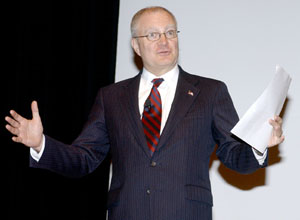 |
|
The old DOE-Re-Mi Marburger tells restive users to bank on exciting research, not spinoffs
by Mike Perricone
Money makes the beam go 'round. Money is the root of all upgrades, and the root of all luminosity. Money also became a pointed source of debate as John Marburger, Director of the Office of Science and Technology Policy and science advisor to the President, offered a Washington-based perspective to the Fermilab Annual Users Meeting on June 2 in Wilson Hall's Ramsey Auditorium. The former director of Brookhaven National Laboratory, Marburger stressed the need to make effective use of limited funding, when tight budgets mean there are only so many resources available in the system--"similar to the law of conservation of energy, though not as elegantly stated." Marburger said OSTP is trying to bring funding agencies together in planning big science, as a reaction to budget pressures. He cited the National Science Foundation and the National Aeronautics and Space Administration beginning to work jointly on plans for building telescopes. Desperate funding, he implied, calls for desperate measures. "If things don't change," Marburger said, "budgets are likely to get less and less adequate for each 'stovepipe' lab effort. It may get to the point where the science is no longer competitive. I'd hate to see that happen." While big science might seem like a bargain to scientists, Marburger countered: "big-apparatus science is expensive, requiring big machines and big computers." The science community is a source of advice for science policy, he said, but the advice must come from a knowledge of funding realities, and of the competitive demands of other labs and other sciences. An electron-positron collider might make sense for high-energy physics, but his question is how it would fit into flat funding. "How much would it cost?" Marburger asked rhetorically. "Take a number-- say $6 billion, and say the U.S. share is a third of that, or $2 billion. You do the math. It'll take 10 years to build, and $200 million a year for our share seems reasonable. At what point do we think the current high-energy physics budget can sustain a $200 million construction effort? That's the kind of thinking we have to start with." From beginning to end, from MiniBooNE data to the nearly completed MINOS far detector, from the Sloan Digital Sky Survey to the closing "open mike" session, the Users Meeting offered a challenge to users' thinking. Fermilab Director Michael Witherell led off the talks by showing the climb in Tevatron luminosity since September 2002. But he offered a draft plan with lower base and stretch goals for integrated luminosity in Run II, and pointed to still tighter budgets in FY '04 and in the foreseeable future. Witherell also announced the formation of a Fermilab Long Range Planning Committee under the leadership of Associate Director for Research Hugh Montgomery. Maintaining the accelerator complex with the 20-year-old Tevatron and the 32-year-old Linac strains staff and budget, Beams Division head Roger Dixon forthrightly reported. The Linac is running on "borrowed tubes," some hard-to-get power amplifier tubes on loan from Brookhaven Lab. With antiprotons the long-range key to luminosity. Dixon has created a dedicated Recycler Department, under Sergei Nagaitsev and Cons Gattusso. Dixon also encouraged users to collaborate on the collider itself. Meeting organizer John Conway of Rutgers University and UEC chair Chris White of Illinois Institute of Technology were pleased with the larger-than-usual turnout of about 500 registrants. In addition to Marburger on the program, Conway was also able to include Robin Staffin, the Department of Energy's deputy associate director for high-energy and nuclear physics, and Marv Goldberg, program director for mathematics and physical sciences at the National Science Foundation. Fred Gilman, chairman of the DOE-NSF High-Energy Physics Advisory Panel, was not on the program but was in the audience. The "open mike" session on Tuesday afternoon fulfilled its mission, leaving the users and the lab with serious questions to consider:
Marburger wasn't present for the open mike session, but some of his comments would have fit well. He said it was critical to compete for funding, not on the basis of technological spinoffs, but on the basis of "exciting research that we have to find out about, ideas that people are interested in, the same approach that worked for the space program." He conceded that the budget process was far from perfect.
"But there is a sense of responsibility in Congress,
to spend consistently with a vision," Marburger
said. "To have an impact on policy, you must
inform yourselves about the process, and interact
in a way that transmits your vision of what should
be done." ON THE WEB: Annual Users Meeting: http://www.fnal.gov/orgs/fermilab_users_org Fermilab Long Range Planning Committee: http://www.fnal.gov/directorate/Longrange/long_range_planning_public.html |
| last modified 6/29/2003 email Fermilab |
FRLsDFx9eyfrPXgV
